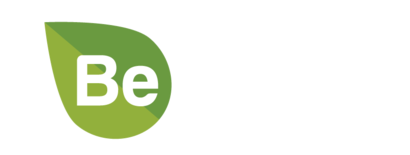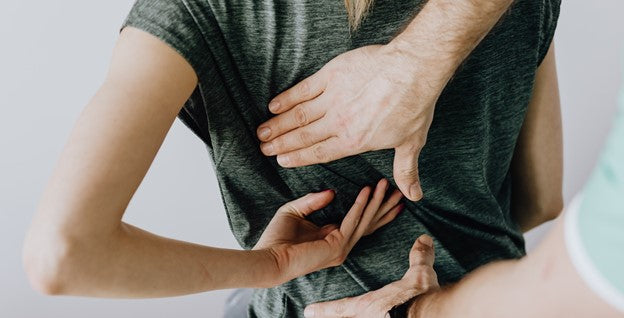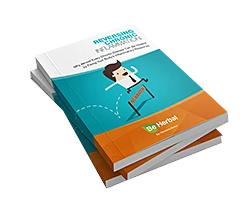bAdvances in technology have been a boon for us in many ways. But the transformation in our lifestyle and habits has led to many health issues.
A common problem faced by almost every person is back pain. Back pain can be of two types middle back pain and lower back pain.
You must have experienced back pain at some point in your life. In most cases, it is not too severe and improves over time. Though there are simple back pain measures that can be taken at home, specialized treatments are available to alleviate back pain.
WHAT IS MIDDLE BACK SPASM?

Middle back spasm is the pain experienced in our back below the neck region and above our rib cage. This area is where our spine is present.
Our spine is a set of vertebral bones stacked over each other separated by discs called vertebral discs. Our spine protects our spinal cord that carries nerve sensations to and from our bodies' various parts to our brains.
Middle back pain is the pain felt in the area of the thoracic vertebrae. Apart from pain, muscle spasms are commonly experienced in the middle back, called middle back spasms.
These muscle spasms are sudden involuntary muscle contractions (i.e., tightening of muscles) that are uncontrollable. This generally occurs in response to muscle strain, overuse, weakness, or muscle pain due to injury or a disorder.
Back spasms may be experienced near the spinal cord or near the nerve roots putting pressure on the sensitive nerves, leading to severe pain.
Muscle spasms commonly occur while exerting excessive strain, like lifting heavy objects, working out, or sporting activities, especially if you have not hydrated yourself well.
WHAT ARE THE SYMPTOMS OF MIDDLE BACK PAIN?
Middle back spasms may range from minor discomfort to severe pain and stiffness preventing normal activities. This, in all probability, could be a red flag for a more serious underlying issue in your spine.
Middle back spasms can occur following an injury to muscles, ligaments, or tendons of the spine. Depending on the causative factor and severity of the issue, one may have several symptoms of middle back pain/spasms:
- Dull pain in the mid-back region to sharp, stabbing, severe pain
- Stiffness
- burning sensation
Other more severe symptoms may include tingling sensations or weakness in the legs, arms, chest, loss of bowel or bladder control, foot drop, hip pain, shoulder or arm pain, etc.
WHAT ARE THE CAUSES OF MIDDLE BACK PAIN AND SPASMS?
Various disorders of the spine may cause spasms resulting from irritation of a nerve connected to a muscle. Spinal stenosis, herniated disc, spinal cord compression may lead to serious injury to various nerves that may be permanent even after relieving pressure. Factors that increase the risk of muscle spasms are :
- Dehydration-lack of water in the body can lead to spasms in muscles.
- Low levels of potassium, calcium ions in the body
- Stiff hamstring tendons
- Weak stomach muscles and weak/ tight muscles of the back
Middle back spasms or pain may be caused by :
- Poor posture: A poor posture exerts a repeated pressure on the spine, causing muscles and ligaments on the back to be strained. Overuse of these muscles causes middle back pain and spasms.
- Obesity: The increase in body weight has been shown to increase the risk of backaches.
- Muscle sprain or strain: This can occur during strenuous activities like the lifting of heavy objects due to a sudden movement
- Fall or other injuries may cause middle back pain like a hard fall, like down the stairs, traffic accidents, trauma, sports accident.
- Herniated disc: when the inner core of the vertebral disks in your back pushes against the outer ring of cartilage, putting pressure on a nerve. This strain on the nerve can result in pain, tingling, or numbness in the middle back.
- Osteoarthritis is a degenerative joint disease occurring when the joint cartilage breaks down, causing bones to rub together.
- Aging: Back pain increases with age as aging causes wearing down of the body leading to thin bones, reduced muscle mass, reduction of joint space, and joint fluid. People in the age range of 30 to 50 years are most likely to experience back pain and spasms.
- Vertebral Fractures occurring due to trauma due to accidents falls, sports injuries, etc., cause severe middle back pain. This pain is so severe that it worsens even on slight movement. This may be accompanied by numbness, sensation, tingling, incontinence when the fracture affects the spinal cord.
HOW ARE MIDDLE BACK SPASMS TREATED?
The treatment of middle back spasms or back pain depends on the cause and severity of the symptoms.
Middle back pain may be fairly common in problems with bad posture or aging to be treated at home with simple, inexpensive remedies. However, if the cause of back pain is any bone, joint, pr disc disorder, or fractures, immediate medical attention must be sought.
Also, if home remedies do not seem to be helping with the symptoms of seemingly innocent back pain, then medical treatment may be necessary.
Home remedies

Some remedies which provide immediate relief from middle back spasms and mid back pain are:
- Applying Hot fomentation and cold packs to the affected area can be helpful.
- Taking over-the-counter painkillers, such as ibuprofen (Advil) and naproxen (Aleve), to reduce swelling and keep the pain at bay
- Maintain good posture during your daily activities
- Epsom salt baths can help relax middle back muscle spasms.
- When obesity can aggravate your middle back pain, it is a good idea to have a healthy and well-balanced diet that is low in transfats, salt, and refined sugars.
Hydration
A common cause of back spasms is dehydration, hence hydrating yourself is extremely important in middle back spasms, especially if you’re exercising or if the weather is hot. Though water intake depends on individual needs, activities, lifestyle, and weather, here is a recommendation by Healthlinespecifying the amount of water that should be taken daily.
Adequate amounts of water and equivalent measurements
|
Women |
2.7 liters |
91 ounces |
11 glasses
|
|
During pregnancy |
3 liters |
101 ounces |
12 glasses
|
|
During lactation |
3.8 liters |
128 ounces |
16 glasses
|
|
Men |
3.7 liters |
125 ounces |
15 and 1/2 glasses |
Exercises
Your physician may recommend some exercises to strengthen your muscles and improve your posture. These exercises help stretch your muscles and relieve spasms.
Manual therapy
Manual therapy is effective in relieving back pain. It involves manual mobilization or manipulation of the spine by chiropractors, who use careful low force to muscles, bone, and joints around the spine.
Medications
Severe back pain treatment may require prescription NSAIDs. Muscle relaxants also help relieve muscle spasms. Your doctor may prescribe some supplements which help build bone density due to osteoporosis.
Surgery
Surgery for back pain is rare but may be required when caused by sciatica, spinal stenosis, disc rupture, or herniation. If your back pain persists more than 72 hours and there is no relief from home remedies, you must see your doctor.
You may be recommended to undergo surgical procedures depending on the cause of your back pain. Some possible surgeries include Laminectomy, Laminotomy, Diskectomy, etc.
How to prevent middle back pain?
Though it is not possible to prevent injuries and accidents, you can avoid back issues by maintaining a good posture and performing exercises to strengthen your back muscles.
- You can try and change your sleeping position if you experience spasms in your middle back early in the morning after waking. If you sleep on your back, you might risk misaligning your spine leading to middle back pain. Sleeping on your side with a pillow placed between your knees or in the fetal position can help.
- It is crucial to maintain a good posture that gives your back muscles a break and allows them to strengthen. Standing and sitting upright and straight, moving your computer screen to the eye level, lowering your chair height so your feet sit flat on the ground, or getting a standing desk are all ways in which you can improve posture.
- You can seek help from a physical therapist who can improve your core strength, posture, and spinal mobility to ensure good spine health.
- Physical activity, yoga, and Exercise can help you build strong, flexible muscles less prone to injury. Additionally, this will also help the healing process for an aching back, improve function, and prevent back problems in the future.
- Various complementary therapies may help relieve low back pain, including acupuncture, spinal manipulation by chiropractors, therapeutic massage to relax aching muscles, movement therapies, such as yoga and tai chi, to stretch and strengthen back muscles.
A myriad of natural and herbal remedies can be taken or used to soothe your back. They can help reduce the intake of medications or provide extra benefit to your existing medical treatment without any side-effects.
Here are some natural pain-relieving strategies which can work wonders for your middle back spasms or middle back pain:
1. Taking Anti-inflammatory beverages daily
Consuming anti-inflammatory foods regularly containing antioxidant, anti-inflammatory, and anti-cancer properties can boost your overall health and immunity.
These potent agents play a significant role in decreasing or eliminating inflammatory reactions in the body. Consuming these healthy drinks regularly may help reduce your back pain.
2. Turmeric milk

Turmeric or Curcumin originates in India and has been used since ancient times in the alternative medicine Ayurveda. It is a vital component of Indian cuisine and is now used worldwide in cooking.
This antioxidant-rich medicinal plant is known to possess anti-cancer properties by preventing DNA mutations. It is derived from the tuberous root of the turmeric plant. It regulates the digestive function and gut health by helping inefficient digestion of food. Its anti-inflammatory properties have been well-known.
Ayurveda has used Turmeric in joint pains, especially in arthritis, to reduce joint inflammation. Turmeric supports immune response, promotes cognitive function and memory. It also has dermatological benefits. People use it on minor cuts and burns to heal faster.
Turmeric has low bioavailability. Consuming it along with pepper can help you absorb more of its benefits. Though it is best consumed with food, many people consume it raw. It can be challenging to gauge the dosages when ingesting raw.
Hence, turmeric supplements can be a good idea in the absence of turmeric powder or the plant. It can be combined with Ginger extract for synergistic effects. Ginger is known to reduce muscle pain, soreness, and many additional properties that further augments Turmeric’s effectiveness.
An easy way to consume Turmeric is to mix a little (around 1/2 teaspoon) of turmeric powder in a glass of warm milk. You can add honey to the milk if you wish to sweeten it. You can consume this drink just before bedtime to allow the anti-inflammatory process to work while you sleep.
You can try plant-based milk, such as soy milk or almond milk if you are lactose-intolerant.
3. Tart cherry juice
Tart cherry is a rich source of antioxidant agents and anti-inflammatory agents.
Tart Cherry juice can help relieve muscle spasms and pain, which is chronic or exercise-induced.
Cherry juice is readily available at grocery stores but make sure it contains the tart cherry extract. Drinking a glass of cherry juice regularly can have positive effects in relieving your back pain.
4. Ginger-green tea

Ginger is a root that is used for its spicy flavor and known for its multiple health benefits. It is a rich source of 25 different antioxidants making it a superhero in fighting free radicals in our body. It is commonly used to reduce nausea and vomiting, especially in motion sickness and morning sickness.
Ginger is a household remedy for sore throats as it soothes your throat from cold and flu due to its antiviral action.
Some studies have shown its potent anti-inflammatory activity beneficial in arthritis and muscle aches. It can be consumed throughout your meal, unlike other herbs- from appetizers, salads, soups to main and side dishes, desserts, and beverages, mainly tea.
Ginger can be taken in infused-herbal drinks, such as ginger-green tea, which contains the pain-relieving benefits of both green tea and ginger.
These anti-inflammatory agents can build up in your bloodstream over a while; hence including these drinks in your daily diet will help reduce overall inflammation and prevent new inflammatory pain.
When using an herbal supplement or topical preparation, discuss it with your healthcare provider before starting to prevent harmful interactions with your other medications, and determine if it is appropriate for you based on your medical history.
A research study found Capsicum frutescens (cayenne) effective in reducing pain more than a placebo. It was also found that Harpagophytum procumbens (devil's claw), Salix alba (white willow bark), Symphytum officinale L. (comfrey), Solidago chilensis (Brazilian arnica), and lavender essential oil reduced pain more than placebos.
5. Topical Application
Over-the-counter pain relief creams may be beneficial. Products that contain lidocaine, camphor, or menthol.
Emollient gels made from Curcuma longa (Turmeric) and celery seed have been reported to ease a muscle spasm's pain and inflammation.
When applied to the skin, capsaicin depletes nerve endings of a neurochemical called substance P, which is essential for transmitting pain sensations to the brain. Hence lesser the substance P in circulation, the lesser is the pain sensation. You can look for a cream or ointment containing 0.075 percent or 0.025 percent capsaicin to apply to the affected area.
6. Bromelain
It is an enzyme that is derived from pineapples. It promotes circulation, reduces swelling, and helps your body reabsorb the inflammatory products. You can take 500 milligrams of bromelain three or four times a day.
7. Valerian
Valerian is a herb whose active ingredient is claimed to interact with the brain's receptors, causing a sedating effect. Though sedatives are not generally recommended, valerian is much milder than any pharmaceutical product.
Valerian can also be made into a tea. Try taking one 250-milligram capsule of valerian four times a day.
Although the evidence is mixed about whether these therapies are effective, they are often combined with the other home remedies for low back pain when they do work.
If you wish to use alternative medicine for back pain, talk with your doctor first. It is imperative to note that self-treating with alternative medicine and avoiding or delaying standard care may be harmful to your health.
TAKEAWAY
If your middle back spasms are frequent, or if the pain is interfering with your routine life, it is a good idea to see a doctor. Imaging tests can be advised to check for possible conditions, such as a fracture, or order blood tests to look for markers for other conditions. Your doctor may refer you for physical therapy to help you strengthen a particular set of muscles or to get flexibility and stretching exercises. If your spasms are prolonged and painful, they may prescribe prescription-strength solutions.


